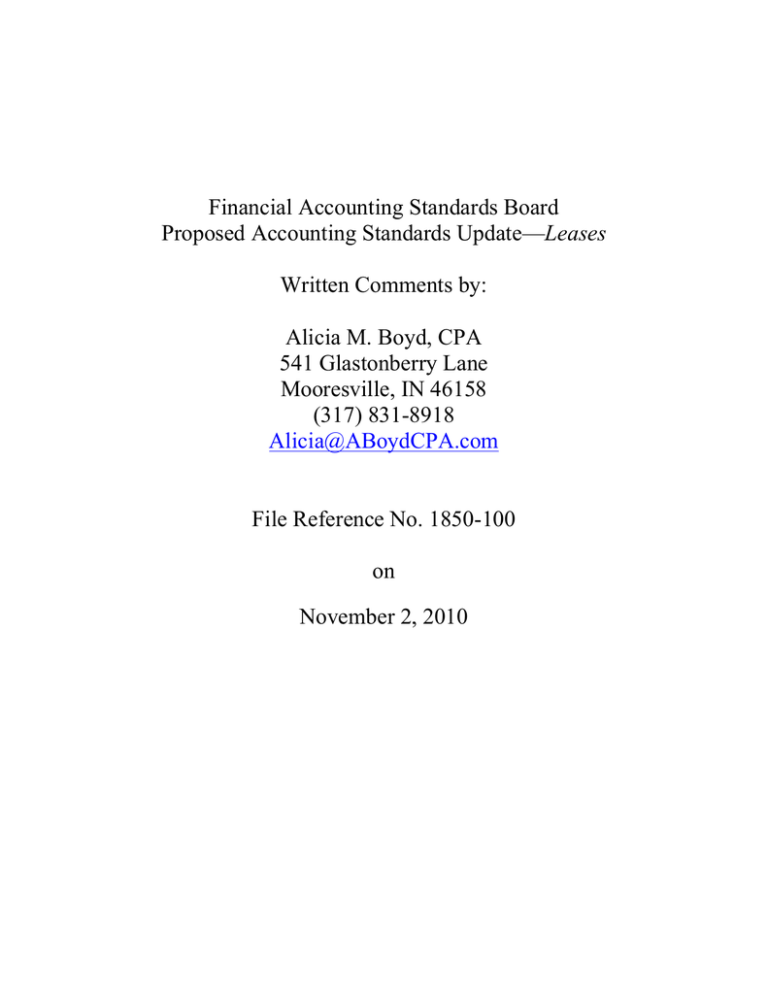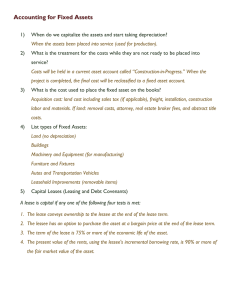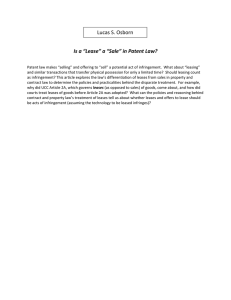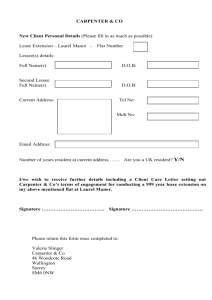Operating Lease Comments.doc
advertisement

Financial Accounting Standards Board Proposed Accounting Standards Update—Leases Written Comments by: Alicia M. Boyd, CPA 541 Glastonberry Lane Mooresville, IN 46158 (317) 831-8918 Alicia@ABoydCPA.com File Reference No. 1850-100 on November 2, 2010 File Reference No. 1850-100 November 2, 2010 Page 2 I am opposed to the boards’ proposal(s) that operating leases be added to the Balance Sheet. Question 2: The proposed new standard should exclude non-core asset leases or short-term leases. See further discussion below. Question 3: I do not agree with the boards’ analysis of the rights and obligations, and assets and liabilities arising in a simple lease contract. See further discussion below. Question 4: I do not support the boards tentative decision to adopt an approach to lessee accounting that would require the lessee to recognize: (a) an asset representing its right to use the leased item for the lease term (the right-of-use asset), (b) a liability for its obligation to pay rentals. See further discussion below. Question 5: I do not support the boards tentative decision to adopt an approach whereby the lessee recognizes: (a) a single right-of-use asset that includes rights acquired under options, (b) a single obligation to pay rentals that includes obligations arising under contingent rental arrangements and residual value guarantees. See further discussion below. Further Discussion: Under an operating lease, the lessee only borrows an asset for a short period of time during the useful life of the asset. When the operating lease ends, there is still a balance of the useful life of the asset available for the owner to either use, or sell for profit. In many instances, operating leases are utilized for vehicles, copiers, and other equipment. Reporting these leases on the Balance Sheet as an asset provides little, if any, added information to the reader of the financial statements. Further, the exclusion of these equipment leases would not sway the reader of the financial statements to either invest or not invest, or lend or not lend. File Reference No. 1850-100 November 2, 2010 Page 3 In fact, including operating leases on the Balance Sheet would seem to be deceptive to the investor or lender, as it gives the appearance that the lessee is utilizing an asset for most of the assets useful life, when in fact, this is untrue. If the board is concerned that debt associated with the operating lease is not reported on the financial statements, a note to the financial statements could easily identify the nature of the asset, as well as the fair market value, term of the lease, and lease payments of each operating lease, with a reference to this note reported directly on the Balance Sheet. By doing this, the Boards’ concerns would have been addressed without materially altering the reporting of operating leases in the financial statements for the lessee. There are various governmental agencies that utilize GAAP in their reimbursement and reporting regulations, including Medicaid, and other state and federal programs. The implementation of the requirement that operating leases, especially operating leases for equipment, be reported on the Balance Sheet similar to a capitalized asset would cause significant harm to many lessees that utilize operating leases in their operations, and has far reaching consequences that the Boards have no way of determining. Various governmental reimbursement systems were designed around a few core concepts, one of which includes the fact that operating leases are reported as expenses, and are not reported on the Balance Sheet. More specifically, Indiana Medicaid reimburses a lessee for the expenditures associated with operating lease payments of equipment. However, very little reimbursement is available from Indiana Medicaid for a capitalized lease or purchase of equipment, as the equipment wears out before it is fully reimbursed by Indiana Medicaid’s predetermined useful life of 7 years. File Reference No. 1850-100 November 2, 2010 Page 4 Equipment such as vehicles, copiers, computers, etc. do not last 7 years. However, if a lessee obtains a lease that is required to be capitalized under the Boards’ approach discussed herein, it will be amortized over 7 years under Indiana Medicaid regulations. If the equipment wears out or is totaled after 2 years, the lessee will no longer receive reimbursement from Medicaid for the equipment as the equipment is no longer in service, resulting in lost reimbursement for the lessee. For example, if the lessee remits operating lease payments for two years of a three year term, and a vehicle is totaled, the lessee does not receive full reimbursement for the payments they have made under Indiana Medicaid because reimbursement for the asset is amortized over 7 years, and amortization/reimbursement ends when the vehicle is no longer in service, resulting in substantial financial loss for the lessee. Further, loss on disposal of an asset is not reimbursed by Indiana Medicaid. As such, there would be no way for the lessee to obtain Medicaid reimbursement for the expenditures incurred in the operating lease for the first two years of the three year term, should the Boards implement the approach that operating leases should be reported on the Balance Sheet. I urge the Board to reconsider their proposal to report operating leases on the Balance Sheet, given the wide sweeping consequences such a drastic change could have on many lessee’s reimbursement funding they receive from governmental agencies. This one proposal could cause significant harm to many not-for-profit agencies that are already struggling to survive in these tough economic times. If you have any questions, or would like to discuss this issue in further detail, please do not hesitate to contact me at (317) 831-8918 or Alicia@ABoydCPA.com




